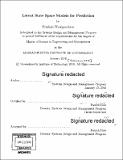| dc.contributor.advisor | Patrick Hale. | en_US |
| dc.contributor.author | Wanigasekara, Prashan | en_US |
| dc.contributor.other | Massachusetts Institute of Technology. Engineering Systems Division. | en_US |
| dc.date.accessioned | 2017-01-06T16:14:38Z | |
| dc.date.available | 2017-01-06T16:14:38Z | |
| dc.date.copyright | 2016 | en_US |
| dc.date.issued | 2016 | en_US |
| dc.identifier.uri | http://hdl.handle.net/1721.1/106269 | |
| dc.description | Thesis: S.M. in Engineering and Management, Massachusetts Institute of Technology, School of Engineering, System Design and Management Program, Engineering and Management Program, 2016. | en_US |
| dc.description | Cataloged from PDF version of thesis. | en_US |
| dc.description | Includes bibliographical references (pages 95-98). | en_US |
| dc.description.abstract | In this thesis, I explore a novel algorithm to model the joint behavior of multiple correlated signals. Our chosen example is the ECG (Electrocardiogram) and ABP (Arterial Blood Pressure) signals from patients in the ICU (Intensive Care Unit). I then use the generated models to predict blood pressure levels of ICU patients based on their historical ECG and ABP signals. The algorithm used is a variant of a Hidden Markov model. The new extension is termed as the Latent State Space Copula Model. In the novel Latent State Space Copula Modelthe ECG, ABP signals are considered to be correlated and are modeled using a bivariate Gaussian copula with Weibull marginals generated by a hidden state. We assume that there are hidden patient "states" that transition from one hidden state to another driving a joint ECG-ABP behavior. We estimate the parameters of the model using a novel Gibbs sampling approach. Using this model, we generate predictors that are the state probabilities at any given time step and use them to predict a patient's future health condition. The predictions made by the model are binary and detects whether the Mean arterial pressure(MAP) is going to be above or below a certain threshold at a future time step. Towards the end of the thesis I do a comparison between the new Latent State Space Copula Model and a state of the art Classical Discrete HMM. The Latent State Space Copula Model achieves an Area Under the ROC (AUROC) curve of .7917 for 5 states while the Classical Discrete HMM achieves an AUROC of .7609 for 5 states. | en_US |
| dc.description.statementofresponsibility | by Prashan Wanigasekara. | en_US |
| dc.format.extent | 98 pages | en_US |
| dc.language.iso | eng | en_US |
| dc.publisher | Massachusetts Institute of Technology | en_US |
| dc.rights | M.I.T. theses are protected by copyright. They may be viewed from this source for any purpose, but reproduction or distribution in any format is prohibited without written permission. See provided URL for inquiries about permission. | en_US |
| dc.rights.uri | http://dspace.mit.edu/handle/1721.1/7582 | en_US |
| dc.subject | Engineering and Management Program. | en_US |
| dc.subject | System Design and Management Program. | en_US |
| dc.subject | Engineering Systems Division. | en_US |
| dc.title | Latent state space models for prediction | en_US |
| dc.type | Thesis | en_US |
| dc.description.degree | S.M. in Engineering and Management | en_US |
| dc.contributor.department | Massachusetts Institute of Technology. Engineering and Management Program | en_US |
| dc.contributor.department | System Design and Management Program. | en_US |
| dc.identifier.oclc | 962186953 | en_US |
